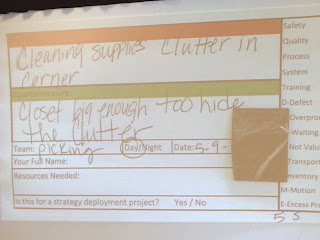One of the dangers of becoming a Lean aficionado is that you see opportunities for process improvement everywhere. Also, you feel an affinity for people who are able to go to
gemba (the place where work is done) and, either by training or by intuition, look at work flows and find ways to improve them. You have sympathy for them when their supervisors are unable to recognize their helpful suggestions or respond approrpriately.
I was giving a talk at a conference in Connecticut today and walked up to the lunch buffet table when I heard one of the servers say to her supervisor, "Shouldn't we move the chocolate cake closer to the coffee? Then, the potato chips can be closer to the sandwiches, too."
Of course, she was right. Look above. The flow of customers gathering their main course is from right to left, using a large plate (not seen here) for their sandwiches, using the condiments, and adding a bag of chips to their plate. The flow of customers getting desert would be from the far end of the table, moving left to right, getting their coffee or tea and picking up some cake using the small plates. As the table is organized, when the two flows get busy, they would interfere with each other.
Her supervisor said, "No, the cake has to be near the B&Bs [the bread and butter plates], so we can't move it."
Well, as you can see, it would be possible to switch the chips and the cake and reconfigure things slightly to still allow the B&Bs to be near the cake.
Sure enough, as lunch proceeded, traffic jams ensued between the people who were picking up their main courses and the ones who had already progressed to coffee and dessert.
I offer this not as a treatise in the proper placement of luncheon foods on a buffet line. I offer it more as an example of a manager who quickly dismissed a suggestion from a staff member without engaging in a reasoned discussion of the alternatives. We see this all the time in hospitals and other organizations, where a manager becomes blindly wedded to "the way we've always done it," and in so doing discourages front-line staff from offering suggestions for process improvement.





